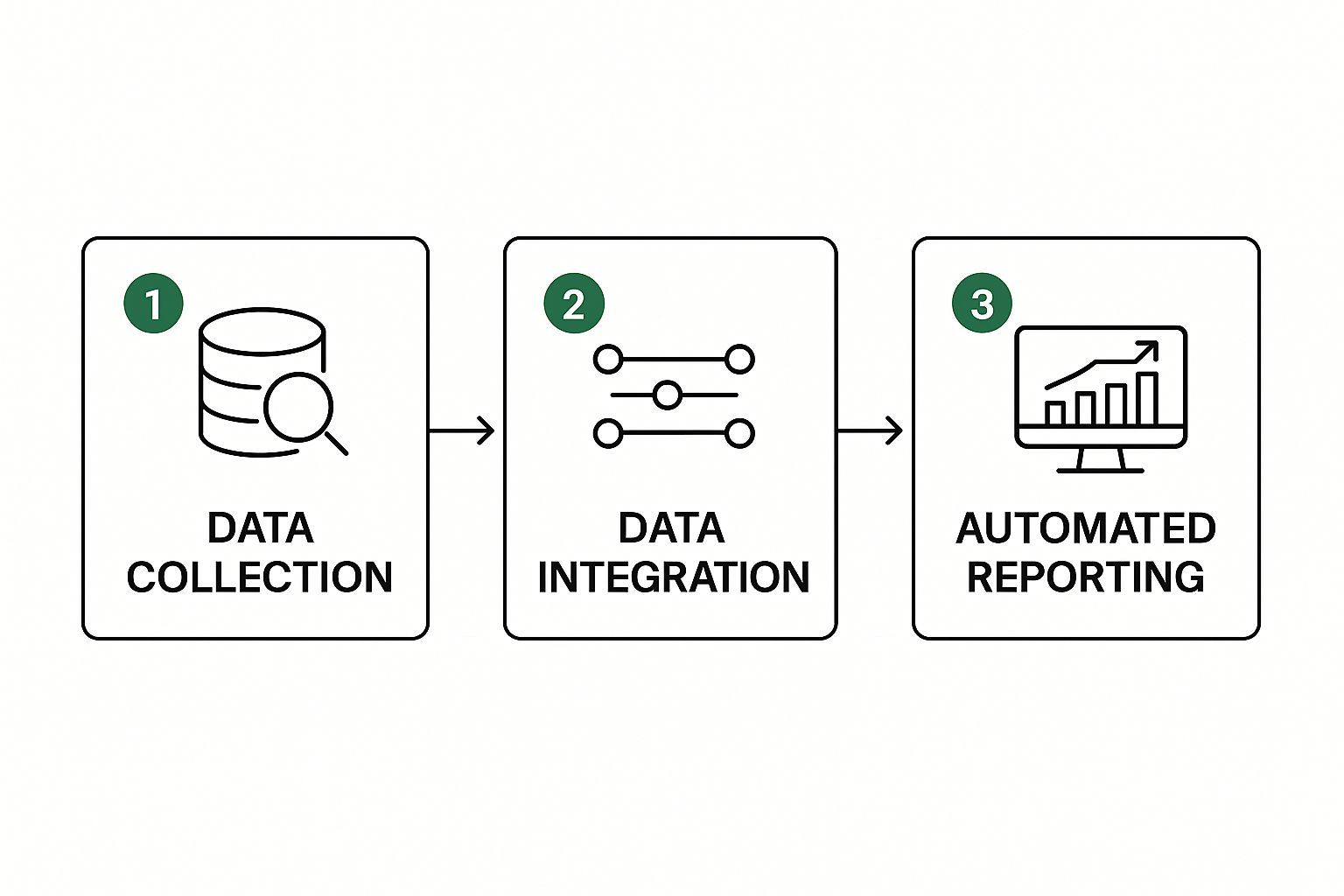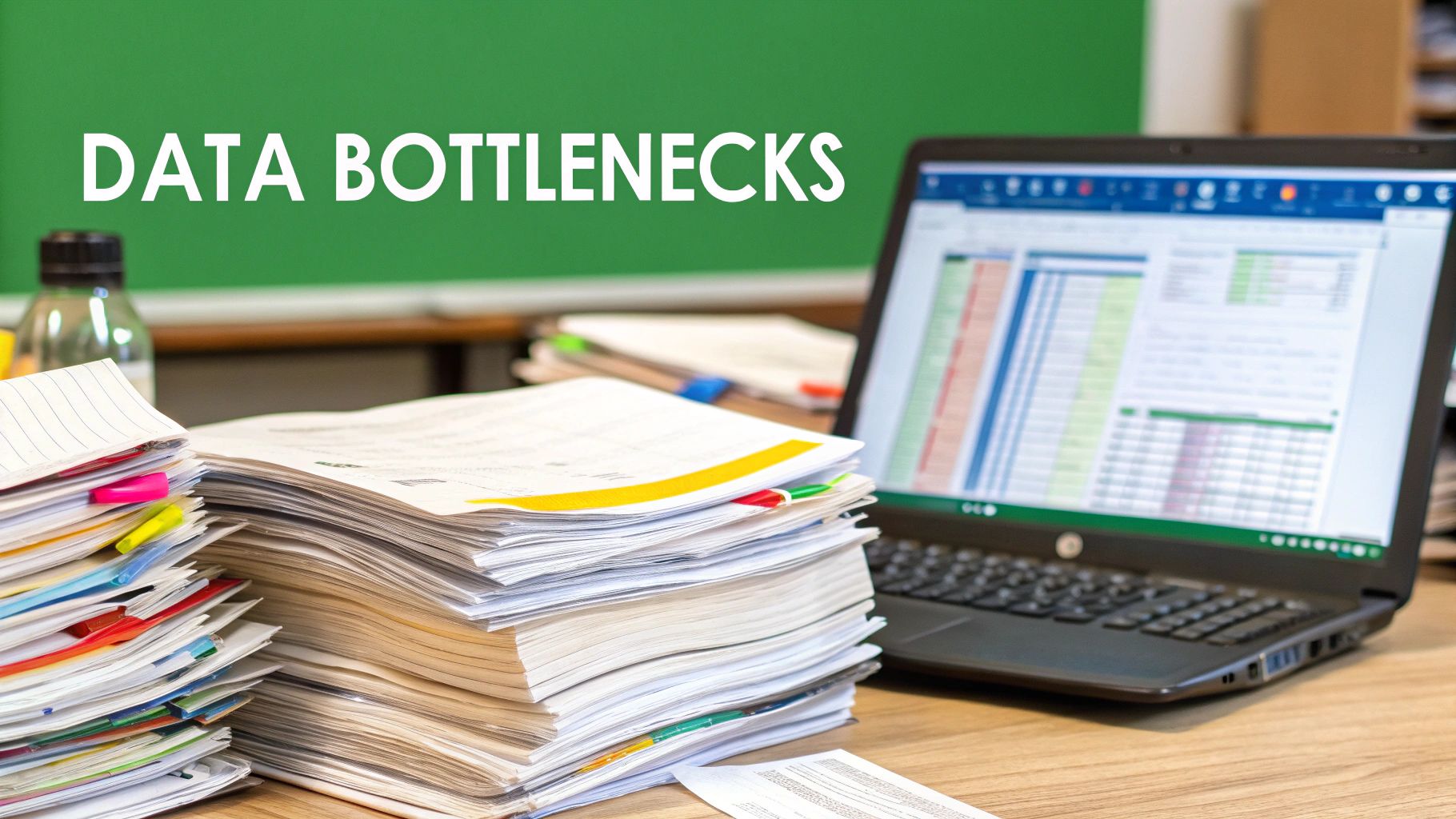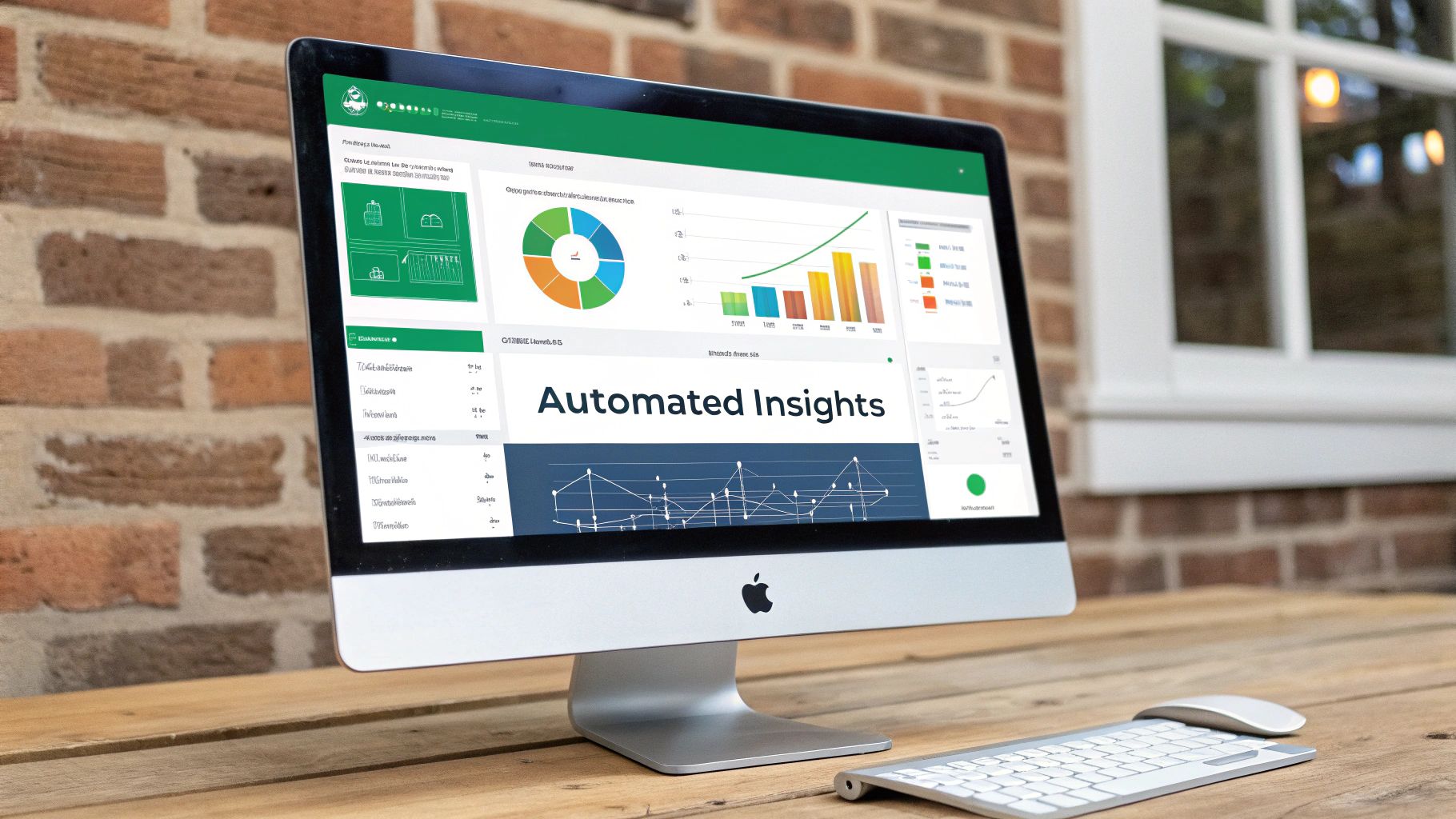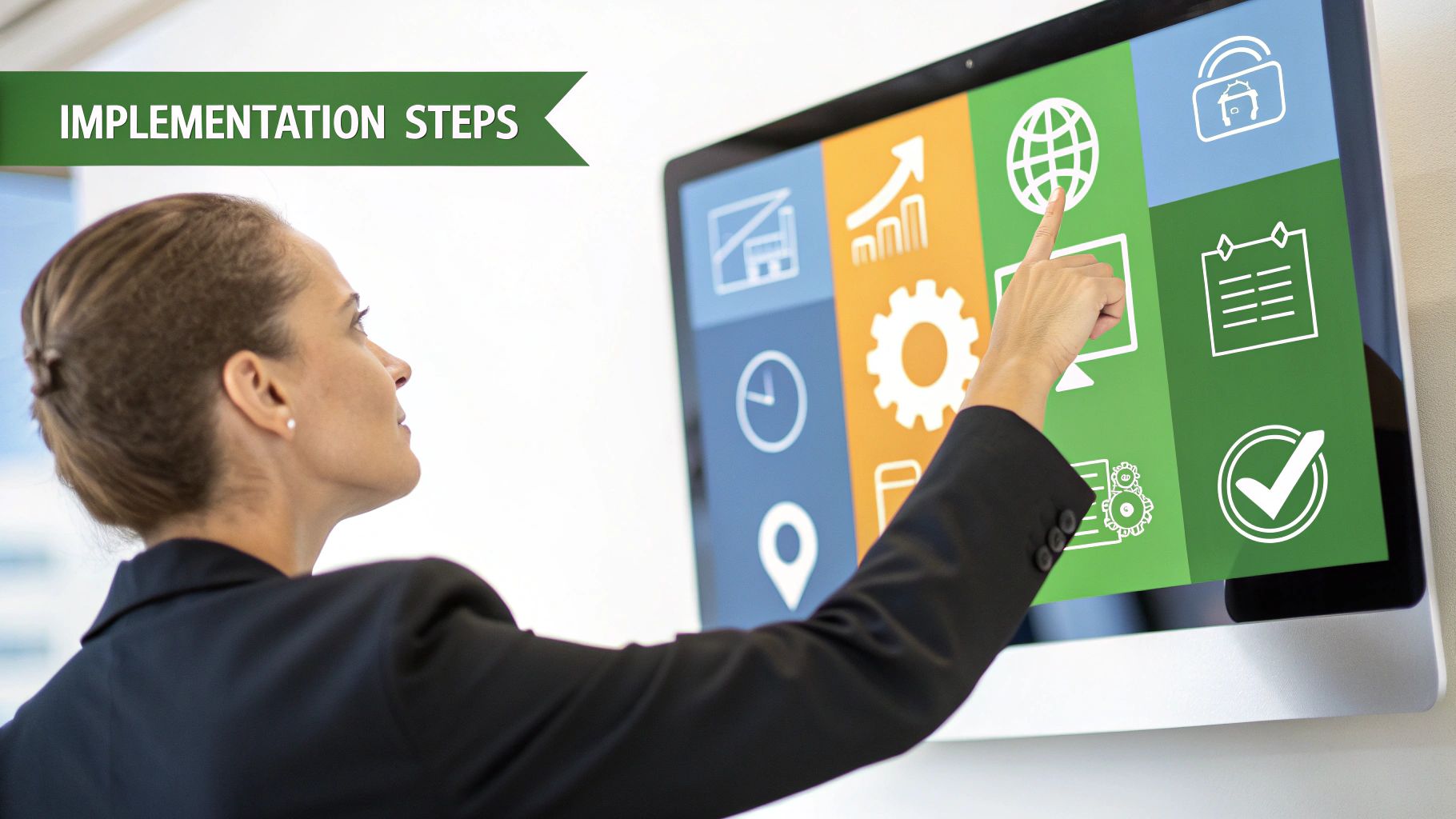Carbon Data Automation for Companies: Boost Efficiency Today
Karel Maly
June 26, 2025
Picture this: your team spends weeks, if not months, buried under a mountain of spreadsheets. They’re chasing down energy bills from different departments, trying to make sense of transport logs, and manually punching in numbers to calculate your company's carbon footprint. After all that work, you still have a nagging feeling the final figures might not be quite right.
For a lot of businesses, this isn't a hypothetical scenario. It's the frustrating reality of carbon accounting. Carbon data automation for companies offers a way out, turning this messy, time-consuming chore into a reliable, ongoing process.
Moving Beyond Manual Carbon Accounting
Trying to manage modern carbon reporting with spreadsheets is like trying to navigate a bustling city with a hand-drawn map. It might get you there eventually, but it's slow, full of potential wrong turns, and simply not built for the complexity you're facing. Teams burn countless hours hunting for utility invoices, deciphering supplier reports, and wrestling with massive, error-prone spreadsheets.
This old-school approach isn't just inefficient; it's a genuine business risk. A simple typo or a miscalculation can ripple outwards, leading to flawed sustainability plans, failure to comply with ever-changing Czech and EU regulations, and overlooked chances to cut costs.
The real headache is the sheer amount and variety of data you need. Your carbon footprint information isn't neatly filed in one place. It's spread out all over the business:
- Online portals from your utility providers
- Logs from your fleet management software
- Invoices and reports from your suppliers
- Expense claims from employee business travel
Pulling all this information together by hand is a constant struggle. By the time you’ve gathered and organised everything, the data is already old news. This makes it incredibly difficult to make smart, forward-looking decisions.
The Shift to Automated Workflows
This is where automation completely changes the picture. It builds a digital bridge, connecting all those scattered data sources directly to your final, audit-ready reports. Instead of someone manually pulling information, an automated system handles the collection, ensuring your data is always up-to-date and accurate.
By automating the data pipeline, you free up your team. They can stop spending their time on tedious data entry and start focusing on what really matters: analysing the insights and taking meaningful action. It transforms sustainability reporting from a painful administrative task into a tool for smarter business decisions.
Let's look at how the two approaches stack up.
Manual vs Automated Carbon Data Management
| Feature | Manual Carbon Tracking | Automated Carbon Data |
|---|---|---|
| Data Collection | Time-consuming manual entry from bills, logs, and invoices. | Direct integration with systems (utilities, ERPs) for real-time data feeds. |
| Accuracy | High risk of human error from typos and miscalculations. | Significantly reduced error rates with validated, machine-led processes. |
| Speed & Timeliness | Slow and reactive; reports are based on historical, often outdated data. | Fast and proactive; near real-time data allows for immediate insights. |
| Team Focus | Staff are bogged down in low-value administrative tasks. | Teams are freed up to focus on strategic analysis and reduction initiatives. |
| Audit Readiness | Difficult to trace data back to its source, making audits challenging. | Creates a clear, auditable trail from source to final report. |
| Scalability | Becomes exponentially more difficult as the company grows or adds new data sources. | Easily scales to handle growing data volumes and business complexity. |
The difference is clear. Automation isn't just about doing the same thing faster; it's about creating a fundamentally better, more reliable system for managing your environmental impact.
The process flow below shows how carbon data automation for companies elegantly organises this complex job into three simple, continuous steps.

This model illustrates how automation builds a dependable, hands-off system that turns raw, messy data into clear, actionable insights, getting rid of the manual bottlenecks for good.
How Carbon Data Automation Actually Works

So, what’s really going on under the bonnet? Carbon data automation for companies is a process that uses technology to automatically gather, analyse, and report on emissions data from every corner of your business—from utility bills and fleet mileage to the complexities of your supply chain.
Think of it like a smart home system. You don't walk around your house manually adjusting every light and thermostat. Instead, a central hub connects to all your devices, learns your habits, and makes intelligent adjustments for you. This saves you time and energy without constant fiddling.
In much the same way, automation platforms use digital “connectors” to pull data from all the different places it lives. The platform then translates those raw numbers into audit-ready reports and genuine business intelligence, freeing your sustainability teams from the drudgery of manual data work.
The Three Pillars of Automation
At its core, this whole process stands on three key pillars. Each one takes a traditionally manual, error-prone task and replaces it with a reliable, tech-driven workflow. The result is a dependable system for managing your carbon footprint.
-
Automated Data Collection: This is where it all begins. The system uses Application Programming Interfaces (APIs) to link directly with the software you already use, like accounting systems, ERPs, and utility provider portals. It can even use clever techniques like image recognition to scan PDF invoices and pull out energy usage data, completely sidestepping manual entry.
-
Centralised Data Processing: Once collected, all that varied information flows into one central hub. Here, it gets cleaned up, standardised, and sorted according to established greenhouse gas (GHG) reporting standards. The system automatically applies the correct emissions factors to calculate your footprint across Scopes 1, 2, and 3.
-
Intelligent Reporting and Analysis: The final pillar is where the data becomes truly valuable. The platform can generate audit-ready reports for regulators and stakeholders at the click of a button. More importantly, it provides real-time dashboards and analytics that help you spot trends, pinpoint emissions hotspots, and even test out the potential impact of different reduction ideas.
From Raw Data to Actionable Insight
The true magic here is how automation connects data streams that were once completely separate. Let’s take the emissions from employee business travel as an example.
An automated system can link directly to your company’s HR or travel booking software. When an employee books a flight, the system instantly grabs the travel distance and mode of transport, calculates the resulting emissions, and assigns them to the right department. This all happens in the background, creating a complete and accurate record without anyone having to touch a spreadsheet.
This constant, seamless flow of information means your data is not just accurate, but also incredibly timely. Instead of reviewing a report that's already six months out of date, you can see your emissions footprint as it stands right now. This allows your business to be proactive, making fast, data-backed decisions that cut your environmental impact and boost efficiency.
Ultimately, this transforms carbon accounting from a backwards-looking compliance exercise into a powerful, forward-looking strategic tool.
Keeping Pace with Czech and EU Climate Regulations

For Czech businesses, the need to track and report emissions isn't some far-off idea anymore. It's a genuine operational reality, driven by serious climate policies at both the national and EU level. These aren't just aspirational goals; they are legally binding rules that demand precise, verifiable data from companies.
This new reality is built on major commitments. The Czech Republic's climate strategy, for example, is directly tied to its EU obligations. Under the National Energy and Climate Plan (NECP), the country aims for a 30% reduction in total greenhouse gas emissions by 2030, benchmarked against 2005 levels. That's a target of cutting around 44 million tonnes of CO₂ equivalent. More detail on the Czech NECP's specifics is available through the European Commission.
Hitting this national target relies heavily on the private sector stepping up with strict monitoring. This is where carbon data automation for companies stops being a "nice-to-have" and becomes a critical tool for staying compliant and managing risk.
Making Sense of Complex Rules
For many businesses, the most immediate pressure point is navigating directives like the EU Emissions Trading System (ETS) and the newer Corporate Sustainability Reporting Directive (CSRD). These regulations demand a standard of detail and accuracy that is almost impossible to maintain with manual tools like spreadsheets.
An automated system brings the necessary precision by creating a clear, continuous data trail. It shows auditors and regulators that your emissions numbers aren't just ballpark figures but are rooted in actual, verifiable operational data pulled directly from the source.
It’s a bit like the difference between keeping your books in a handwritten ledger versus using modern accounting software. The ledger might give you the basics, but the software provides the irrefutable proof and detailed transaction history you’d need for a financial audit. Automation delivers that same level of confidence for your environmental data, building a solid, defensible compliance record.
Shifting from Burden to Advantage
Meeting these regulations is about more than just dodging penalties. It's about future-proofing your business in an economy where environmental performance is increasingly tied to financial stability and market access. Sloppy or incomplete reporting can have very real consequences.
- Financial Penalties: Failing to comply with frameworks like the EU ETS can lead to significant fines.
- Reputational Damage: In today's transparent world, poor environmental reporting can quickly tarnish your brand and scare off investors.
- Operational Blind Spots: Manual tracking often overlooks key emission sources, meaning you miss out on identifying the best opportunities for reduction.
By bringing in automation, you can move from a reactive, compliance-first mentality to a proactive, strategic one. The detailed insights these systems generate don't just tick regulatory boxes; they reveal efficiencies that can make your entire business stronger. As you explore your options, getting to know the top GHG emissions reporting software is a smart first step. It helps you see how carbon data automation can be more than a necessity—it can be your path to a more resilient and competitive future.
The Real Business Case for Automation
Of course, staying on the right side of regulations is a powerful push, but the real power of carbon data automation for companies lies far beyond just ticking compliance boxes. The genuine business case is all about boosting profitability and building a more resilient company. It’s about turning what feels like a chore—sustainability reporting—into a strategic asset that directly strengthens your bottom line.
Think of it this way: without automation, you're navigating with a blurry, outdated map. With it, you get a high-definition, real-time satellite view of your entire operation. Suddenly, you can see exactly where energy and resources are going to waste. This clarity lets you pinpoint specific inefficiencies and unlock major cost savings that were buried in complex, messy data.
Turning Data Into Dollars
The financial squeeze on traditional energy sectors tells a story every business should hear: getting ahead of your carbon management is crucial for survival. This is especially true here in the Czech Republic, where the economic ground is shifting under the energy industry's feet.
A recent analysis revealed that 60% of coal capacity in the Czech Republic is already losing money. That number is projected to jump to a staggering 91% by 2030 as market dynamics and new rules take hold. This reality is forcing a faster shift to cleaner energy and more efficient operations, and you can’t manage that transition without tracking emissions meticulously. You can dig deeper into these economic pressures on the Carbon Tracker Initiative website.
For your business, this means every unit of energy you save isn't just good for the planet—it's a direct win for your finances. Automation provides the detailed data you need to make smarter calls, whether that’s optimising delivery routes, finally replacing that old, inefficient piece of machinery, or even renegotiating with suppliers based on their own carbon performance.
These aren't just small tweaks. They cut operational costs, make you more competitive, and build the kind of long-term resilience your business needs to thrive as the economy changes.
From Reporting Burden to Strategic Advantage
Ultimately, automation flips the entire script. What was once a reactive, time-draining reporting task becomes a proactive engine for creating real business value.
You’ll see the benefits ripple across the entire organisation:
- Operational Efficiency: Pinpoint and eliminate energy waste in your factories, vehicle fleets, and production lines.
- Financial Savings: Lower your utility bills, cut fuel costs, and avoid potential carbon taxes or fines.
- Enhanced Competitiveness: A leaner, more efficient operation always has an edge in the market.
- Informed Decision-Making: Use precise, up-to-the-minute data to guide your biggest investments and operational shifts.
By automating the grunt work, you free up your team to focus on strategy, not spreadsheets. The insights you gain are fundamental for success, and choosing the right business carbon footprint tool for your enterprise is a critical first step. It's a strategic move that ensures your sustainability efforts contribute directly to a healthier bottom line.
What to Look For in a Carbon Automation Platform

When you're ready to bring in a dedicated tool, it's vital to know what separates a genuinely useful platform from a simple data repository. Not all systems offering carbon data automation for companies deliver the same value. The best ones give you a powerful toolkit for making real environmental progress and staying on the right side of regulations.
First things first, look for seamless integration. The platform absolutely must connect with the systems you already use, like your Enterprise Resource Planning (ERP) software or utility provider portals. This creates an automatic, steady flow of data, cutting out the tedious manual entry that so often leads to mistakes.
A clear, real-time dashboard is another non-negotiable. You need a single screen where you can get an instant, easy-to-grasp snapshot of your emissions across the entire business. It should immediately show you where your biggest problem areas are and how you're tracking against your reduction targets.
Comprehensive Emissions Tracking
For a platform to be truly effective, it needs to give you the full picture of your carbon footprint. This means it must be built to handle all three emissions scopes with accuracy.
- Scope 1: These are the direct emissions from sources you own or control. Think of the fuel burned in your company's vehicles or emissions from on-site manufacturing.
- Scope 2: This covers the indirect emissions from the energy you buy—mainly electricity, but also any purchased heating and cooling.
- Scope 3: This is the big one. It includes all other indirect emissions up and down your value chain, from supplier activities and business travel to how your products are used by customers. For most companies, this is the largest and trickiest part of their footprint to measure.
A top-tier platform doesn't just tell you what happened last quarter. It should give you forecasting and scenario-modelling tools. This lets you play out different "what if" scenarios—like switching to an EV fleet or changing suppliers—to see the potential impact before you invest time and money. It’s how you move from just reporting numbers to setting and hitting ambitious targets that impress investors and regulators.
Reporting and Predictive Analytics
Let's talk about compliance. Manually pulling together reports is a nightmare, so automated report generation is a must-have. Your platform should be able to create audit-ready reports formatted for major standards like the CSRD or the Global Reporting Initiative (GRI) at the click of a button. It turns a major headache into a simple, repeatable task.
The pressure for this kind of accuracy is only growing. In the 2025 Climate Change Performance Index (CCPI), the Czech Republic was ranked 49th globally, landing it in the low-performing category because of shortfalls in energy efficiency and emissions reduction. For Czech companies, this signals more intense regulatory focus ahead, making robust carbon data automation for companies an essential tool, not just a nice-to-have. You can dig into the specifics in the official CCPI country report.
Your Step-by-Step Implementation Roadmap
Ready to move beyond manual spreadsheets and into a more powerful system? Adopting carbon data automation for companies isn’t about a massive, disruptive overhaul. It's much smarter to break the process down into manageable stages, ensuring a smooth and strategic shift that starts delivering value almost immediately.
Think of it less like flipping one giant switch and more like a phased upgrade. This approach lets you manage complexity, sidestep common hurdles like internal resistance, and build positive momentum right from the start. A successful journey always begins with a clear, actionable plan.
Phase 1: Define Your Goals and Scope
Before you even think about technology, you need to get crystal clear on what you want to achieve. What’s the main driver? Is it to meet specific Czech or EU regulations? Or are you more focused on finding cost savings and strengthening your brand’s green credentials? Defining these objectives upfront is your foundation.
With your goals in mind, you can then map out your reporting scope. Decide if it makes more sense to start with Scope 1 and 2 emissions—that’s the carbon from your direct operations and the energy you buy. Or, maybe you need to tackle the much trickier Scope 3 value chain emissions from day one. There's no single right answer, but you need to make a conscious choice.
Phase 2: Pinpoint Your Data Sources
Right now, your emissions data is likely scattered all over the business. The next crucial step is to hunt it down and identify every key source to ensure your tracking is complete.
- Utility Invoices: Dig out all your electricity, gas, and water bills.
- Fleet Management Systems: Pull fuel consumption and mileage data from your vehicles.
- Supplier Information: Gather data related to the goods and services you purchase.
- Employee Expenses: Don't forget about business travel, hotel stays, and commute data.
Putting together this data inventory is absolutely vital. It’s what helps you choose the right automation partner and map out a realistic integration plan.
A smart way to start is with a focused pilot project. Pick one department or a single operational area to test the new system. This lets you prove the value of automation on a smaller, more manageable scale, iron out any early wrinkles, and build an internal success story that gets everyone else on board.
Phase 3: The Technical Integration
Once you’ve picked your partner, the real technical work can begin. This is where you connect the automation platform to all those data sources you identified, typically using APIs and other digital tools. If you want to get into the nitty-gritty of how that works, have a look at our guide to API integration for seamless implementation.
Lastly, and this is key, focus on your people. Roll out proper training so your team feels confident using the new dashboards and analytical tools. This is what empowers them to stop spending time on data entry and start making strategic, informed decisions that actually shrink your company's carbon footprint.
Common Questions About Carbon Automation
As companies start seriously looking into automating their carbon accounting, a handful of questions pop up almost every time. It's smart to tackle these concerns directly, as it helps clear up any confusion and shows just how practical this technology really is. Getting these answers right helps everyone make decisions with confidence.
Let's dive into what people usually ask.
What’s the Real Cost of This Technology?
The first thing on everyone's mind is usually the price tag. Naturally, the cost will vary depending on how big your company is and how complicated your operations are. But thinking of it as just another expense is the wrong way to look at it. To get the full picture, you have to think about the return on investment (ROI).
Automation creates real savings. It shines a light on energy waste, helps you use resources more efficiently, and can save you from hefty fines for not meeting regulations. It’s an investment in making your business run better—one that pays for itself over time, not just another line item on the sustainability department's budget.
How Does It Handle Complex Scope 3 Emissions?
Everyone knows that tracking Scope 3 emissions—the indirect carbon footprint from your entire supply chain—is a massive headache. This is exactly where modern automation platforms show their worth. They go far beyond what you could ever manage with a spreadsheet by using several clever methods at once.
- Supplier Portals: These are simple tools that make it much easier to ask for and collect emissions data straight from your suppliers.
- Industry Databases: Good platforms tap into huge databases filled with industry-average emissions data, which helps fill in the gaps when you don't have perfect information.
- Direct System Links: By connecting directly to your logistics and purchasing software, automation can pull in the necessary activity data for incredibly accurate calculations.
What was once a daunting challenge—mapping out your supply chain's footprint—becomes a structured and manageable process.
Is Our Company Too Small for This?
This is a common misconception that really needs to be put to rest. The idea that automation is just for giant corporations is completely outdated. Today, with flexible, cloud-based software (often called SaaS), this technology is well within reach for small and medium-sized businesses.
In fact, getting started early can give smaller, more agile companies a real advantage. By building a solid foundation of accurate emissions data now, they can make smarter decisions as they grow, attract customers who care about the climate, and stay ahead of future rules without the last-minute scramble.
Adopting automation isn't about how big you are anymore; it's about being smart and planning for the future.
Ready to turn your sustainability reporting from a manual chore into a genuine business advantage? Carbonpunk’s AI-driven platform automates data collection and delivers actionable insights to cut emissions and costs. Discover how we make complex carbon accounting simple at https://www.carbonpunk.ai/en.